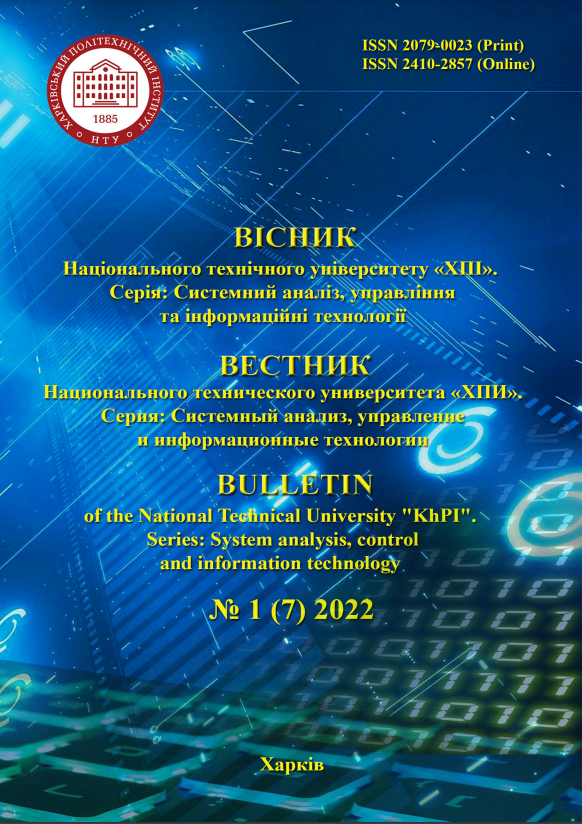THE APPROACH AND THE SOFTWARE TOOL TO CALCULATE SEMANTIC QUALITY MEASURES OF BUSINESS PROCESS MODELS
DOI:
https://doi.org/10.20998/2079-0023.2022.01.11Keywords:
business process modeling, semantic quality, quality measure, natural language processing, software toolAbstract
Business process models are essential business process management artifacts that help describe visually ongoing business activities to facilitate communication between information technology and business stakeholders. Business process models are used to find inefficient spots within described workflows and resolve detected shortcomings by automation via configurable software solutions or unified workflow engines. However, this is impossible when using syntactically or semantically poor business process models. It is the same as building a house using the blueprint with windows on the floor and typos in text labels. Therefore, it is extremely important to keep created business process models clear and relevant to the actual workflows they describe. Hence, in this paper, we propose the approach and the software tool to calculate semantic quality measures of business process models. The proposed approach uses a special procedure to extract the modeling domain statements using natural language processing techniques. According to the proposed approach, the initial textual descriptions of business process models should be tokenized. Then obtained tokens should be turned to the lower case style and cleansed to remove non-alphabetic tokens and stop words. Finally, the remaining tokens should be stemmed and the existing duplicates should be removed. The same procedure is then repeated for text labels attached to the business process model activities. Then, tokens present in the result of textual description’s processing but missing in the result of labels’ processing are considered incomplete (i.e. incorrect in the modeling domain). Similarly, tokens present in the result of labels’ processing but missing in the result of textual description’s processing are considered invalid (i.e. irrelevant to the modeling domain). Therefore, respective semantic quality measures can be calculated. The software tool is created using the Python programming language because of its powerful natural language processing packages.
References
Kopp A., Orlovskyi D. Towards the Tokenization of Business Process Models using the Blockchain Technology and Smart Contracts. CEUR Workshop Proceedings. 2022, vol. 3137, pp. 274–287.
Gerth C. Business Process Modeling. Business Process Models: Change Management. Lecture Notes in Computer Science. Springer, 2013, pp. 14–23.
Scheer A.-W. Strategic Business Process Analysis. ARIS – Business Process Modeling. Springer, 2013, pp. 7–20.
Bitkowska A. The relationship between Business Process Management and Knowledge Management – selected aspects from a study of companies in Poland. Business Process Management: Current Applications and the Challenges of Adoption. Cognitione Foundation for Dissemination of Knowledge and Science, 2020, pp. 169–193.
Krogstie J. Quality in Business Process Modeling. Springer, 2016. 250 p.
Allweyer T. BPMN – A Standard from Business Process Modeling. BPMN 2.0: Introduction to the Standard for Business Process Modeling. BoD – Books on Demand, 2016, pp. 9–14.
Deming, IT, and BPM IDEF0 Diagrams. Available at: https://www.bptrends.com/deming-it-and-bpm-idef0-diagrams/ (accessed 25.03.2022).
BPMN Tool Matrix. Available at: https://bpmnmatrix.github.io/ (accessed 25.03.2022).
SourceForge – Search results for “bpmn”. Available at: https://sourceforge.net/directory/?q=bpmn (accessed 25.03.2022).
Kopp A., Orlovskyi D. A Method for Business Process Model Analysis and Improvement. CEUR Workshop Proceedings. 2019, vol. 2403, pp. 1–10.
Kopp A., Orlovskyi D. Intelligent Support of the Business Process Model Analysis and Improvement Method. Information and Communication Technologies in Education, Research, and Industrial Applications. Springer, 2020, pp. 111–135.
BPMN for research. Available at: https://github.com/camunda/bpmn-for-research (accessed 25.03.2022).
Downloads
Published
How to Cite
Issue
Section
License
LicenseAuthors who publish with this journal agree to the following terms:
- Authors retain copyright and grant the journal right of first publication with the work simultaneously licensed under a Creative Commons Attribution License that allows others to share the work with an acknowledgement of the work's authorship and initial publication in this journal.
- Authors are able to enter into separate, additional contractual arrangements for the non-exclusive distribution of the journal's published version of the work (e.g., post it to an institutional repository or publish it in a book), with an acknowledgement of its initial publication in this journal.
- Authors are permitted and encouraged to post their work online (e.g., in institutional repositories or on their website) prior to and during the submission process, as it can lead to productive exchanges, as well as earlier and greater citation of published work (See The Effect of Open Access).


